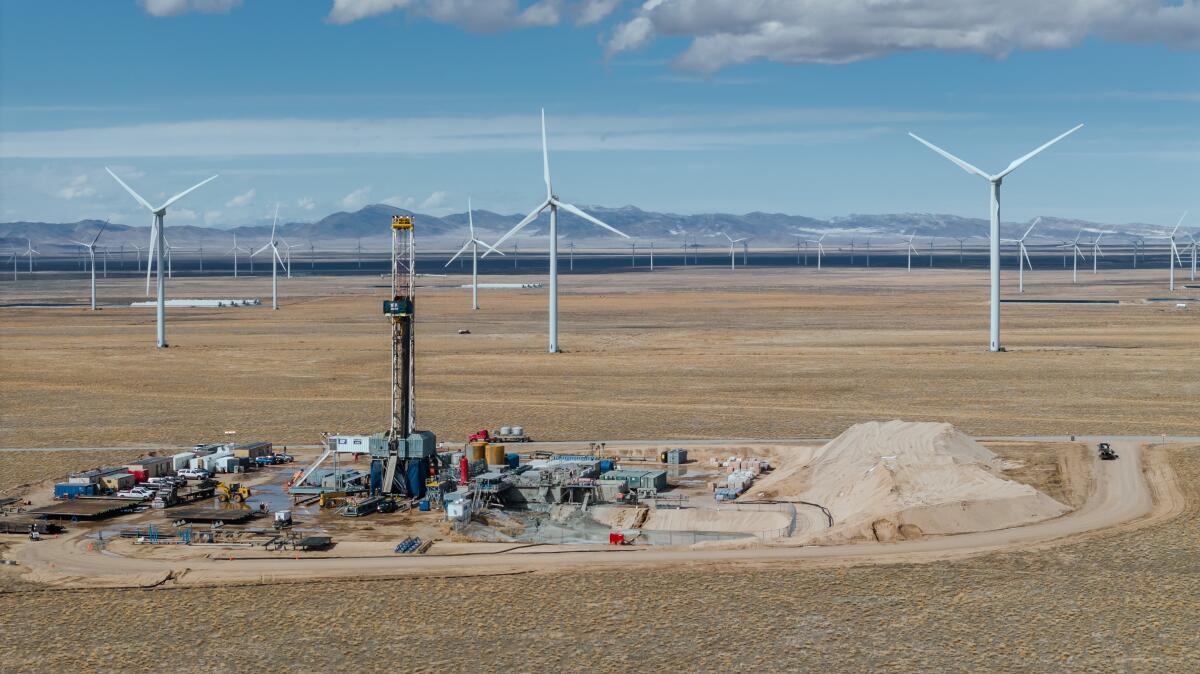Edison CEO: It’s ‘certainly possible’ utility sparked Eaton fire. But climate change made
April 3, 2025
Before sitting down with Pedro Pizarro, president and chief executive officer of Edison International, I gave some thought to how I would ask him about the Eaton fire.
Pizarro lives in Pasadena, not far from the charred remains of Altadena. His company’s biggest subsidiary — the utility Southern California Edison, which supplies electricity to 15 million people — has been accused in dozens of lawsuits of igniting the fire. Should I just straight-up ask him whether the deadly conflagration was Edison’s fault?
Newsletter
You’re reading Boiling Point
Sammy Roth gets you up to speed on climate change, energy and the environment. Sign up to get it in your inbox twice a week.
You may occasionally receive promotional content from the Los Angeles Times.
Turned out I didn’t have to. Pizarro brought up the blaze.
“We still don’t know whether Edison equipment caused the Eaton fire. It’s certainly possible it did. I’ve pledged to be transparent with the public as we continue to investigate,” he said.
“We’ve had a number of our employees impacted. This is heartbreaking for all of us,” he added.
You can listen to my conversation with Pizarro — recorded at Edison headquarters in Rosemead — on the latest Boiling Point podcast, available on Apple Podcasts, Spotify, YouTube and other podcast apps. We talked about the January fires, the climate crisis, California’s rising electric rates, the Trump administration and more.
Here are a few excerpts, edited and condensed for clarity and brevity.
You started leading Southern California Edison in 2014, when the wildfire situation wasn’t nearly as bad as it is today. Did you ever imagine that so much of your time would be consumed by wildfires?
No, I don’t think anybody ever imagined that. I mean, California’s always had wildfires, and there were some really tough ones down in the San Diego area in 2007, for example, outside of our territory. So all the utilities in the state had fire prevention programs. But I don’t think anybody — not utilities, not academics, not government — ever imagined the kind of catastrophic damage we started seeing in 2017.
It’s a convergence of a lot of things. It’s climate change. It’s the building of more and more infrastructure in higher- and higher-risk places. My wife grew up in the area. We met in college back east and then came back for grad school.
Where did she grow up?
In the San Fernando Valley, Tujunga and then Granada Hills. She remembers a fire when they lived in Tujunga, right by the edge of their yard, because they lived up against the hills. They were called forest fires back then, because it was the forest, and very few people lived in the forest.
Now it’s the wildland-urban interface, because as real estate prices got so tough, there was more and more building into these canyons and high-fire-risk areas. So you had a number of things that converged to create these catastrophes that nobody imagined.

The Thomas fire reaches the Pacific Ocean in Ventura County in December 2017.
(Los Angeles Times)
You referenced that in 2017, things started to get much worse. That was the year of the Thomas fire in Ventura and Santa Barbara counties.
Well, it first started with the wine country fires in Northern California. Then the Thomas and Koenigstein fire in our area. Then in 2018, there was the Camp fire up north, with Paradise. And then we had the Woolsey fire. And so those were four large, catastrophic, awful fires in a year-and-a-half, two-year period.
Since then, there’s a lot that we and the other investor-owned utilities have done to harden our systems and deploy all sorts of new equipment.
For example, we have 17,000 miles of distribution wire in the 27% of the Southern California Edison area that’s currently deemed high-fire-risk. Of those 17,000 miles, 7,000 miles were already underground. It’s just how they were built, typically newer developments. Out of those 10,000 overhead miles, over 6,400 are now replaced with insulated wire — covered conductor, we call it.
It reduces the risk that the lines are going to spark a fire.
Exactly. We have added other equipment that helps reduce the risk of fire, like fast-acting equipment, etc. More stringent vegetation management, tree trimming, the use of Public Safety Power Shutoffs —
That’s preemptively turning off the power when the risks are high.
And we’ve been able to target the shutoffs more and more narrowly as we add more equipment. But they’ve still been a tool of last resort.
We’ve also added weather monitoring equipment, high-definition cameras. All of these things together have helped reduce the risk of catastrophe. And in fact, we turned over our data to an outfit called Moody’s RMS. They estimated that Edison’s work had reduced the risk of our equipment starting a catastrophic fire, as of the end of last year, by 85% to 90% compared to pre-2017.
However, we’ve always known the risk can never be zero.

Electrical lines and towers in the general area where the Eaton fire may have been sparked.
(John McCoy / For The Times)
Utility infrastructure is not the only cause of fires. We live in a tinderbox when it’s dry and hot in California. And those conditions are, as you alluded to, getting worse with climate change.
But why is it that many of the biggest, most destructive fires seem to be caused by utility infrastructure? I’m thinking of the Thomas and Woolsey fires with Edison, and the Camp fire and wine country fires with Pacific Gas & Electric. It seems like power lines spark some of the worst ones.
First, as electric utilities, we have an obligation to serve everyone, everywhere, no matter the risk. If we were a ‘normal’ business or could make those choices on our own, there are areas that we would probably choose not to serve. Higher-fire-risk areas where we might decide, if we had that discretion, not to put infrastructure in.
But of course we have to put infrastructure in. And it’s frankly an honor to be able to serve those communities. And we’ve been doing that for almost 140 years.
There’s also the fact that we’ve had more and more homes and businesses built in California in these high-fire-risk areas. The wildland-urban interface. So we need to serve the infrastructure there. And if something happens that we couldn’t prevent in spite of all our efforts, then the risk of that fire becoming large, spreading quickly, is much higher. Then on top of that, add in climate change and more extreme weather patterns.
Your company and the other investor-owned utilities, PG&E and San Diego Gas & Electric, have spent a lot of money trying to prevent wildfires. Those billions of dollars are ultimately paid for by customers.
I’m wondering, though: Are we collectively spending too much money trying to get ignition risks as close to zero as possible, when one consequence is higher electric bills for millions of Californians? Should we be willing to spend a little less money on fire prevention if it means lower electric bills?
The cost of action is high. But the cost of inaction is a lot higher.
The reality is, even if you take a look at the January events this year, the Eaton fire and the Palisades fire — after the first wave of the windstorm, we saw something like 50 or 60 different things on our system that might have been yet another ignition, if not for all the investments we had made in things like covered conductors, in things like Public Safety Power Shutoffs. So the investments are actually making a difference.
The largest driver of bill increases over the last five years was not actually wildfires. It was power market costs. Coming out of the 2020 heat waves, you saw power shortages in California, the first rotating outages in two decades since the energy crisis. That sent power prices very high across the state.
As we move forward, we’ve estimated that our system average rate increases are going back down to inflation levels for the 2024 to 2028 period. We believe that our rate increases will be about 2.6% per year through 2028.
But even if rate increases come back down to inflation, that’s still coming from a starting point of rates that are really high. They’ve gone up something like 50% over the last five years.
System average rates in California are certainly higher than the national average. We have been working really hard at Edison over the last decade on minimizing our cost increases, reducing our operations and maintenance costs. Today, our system average rates are something like 30% lower than those of our peers, PG&E and SDG&E.
The other lens that’s important: Our investments are crucial to helping our economy take steps to both mitigate climate change and adapt to the climate change that’s already baked in.
The adaptation part is things like the investments we’ve had to make for wildfires. Because climate change is a big element of the wildfire risk that we’ve seen. I think as a society we have more investments coming, because we see something like 3 feet of average sea level rise by 2050. We see a 20% increase in wildfire ignition risk across all ignition sources by 2050.
Edison’s infrastructure investments are also enabling a strong power grid that can help people electrify across the economy. We’re already seeing it in California. In California today, 25% of new vehicle sales over the last couple of years have been electric. Compare that to 10% across the rest of the country.

Southern California Edison agreed last year to buy 320 megawatts of climate-friendly power from a Utah geothermal project, currently under construction near the Milford wind farm, which supplies electricity to Los Angeles.
(Fervo Energy)
Let’s talk about Edison’s bottom line. Your company doesn’t make money on electricity sales, but you do make money on infrastructure investments. Your equity investors get a return on investment right now of 10.33%. That’s the profit margin Edison customers are charged for investments like burying power lines to prevent wildfires, or building new power lines to fuel electric vehicles.
Last month, your company put in a request to the California Public Utilities Commission to raise the profit margin for equity investors from 10.33% to 11.75%. This was after Southern California Edison made a profit of $1.62 billion last year, its biggest profit in almost 25 years.
There are a lot of folks looking at their electric rates going up and wondering how can Edison be asking for higher profit margins right now.
That’s a fair question, and I’m glad you asked it. We rely on investors to put capital upfront, so that customers don’t have to come up with the $6 billion that we invested last year. Because of the great needs that we have, we see that investment going up to as much as $8 billion a year over the next several years.
Those investors have a choice as to where to invest. There are a lot of other electric utilities across the country in states that carry lower risks than our territory carries.
You’re talking about wildfire risk?
Whether it’s wildfire or other risks, every state has its own different set of risks and and rewards.
And so what we do is we hired an outside expert. They bring in independent expertise. And they took a look at what utilities like us are earning across various states, and they tried to normalize that for the various risks. They came up with a range of something like 10.7% to 11.75% as the fair range that an investor would expect to invest capital into Edison, given our particular risk.
By the way, I’ll point out that there are other examples in areas that don’t have the same wildfire risk. I believe one of the large Florida utilities put in a request for an 11.9% return on equity. And so, understand that this is commensurate with other utilities.
For more from my conversation with Pizarro — including his thoughts on the Trump administration, rooftop solar incentives and the potential to rebuild Altadena without natural gas hookups in homes — listen to our full back-and-forth on your podcast app of choice, or on YouTube.
Search
RECENT PRESS RELEASES
Related Post




